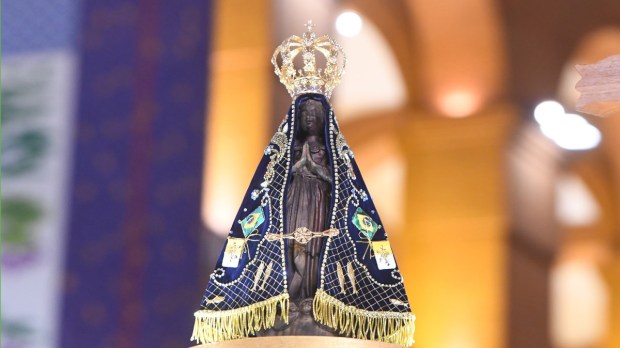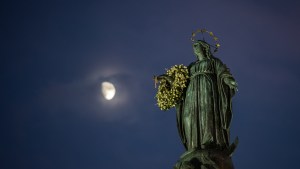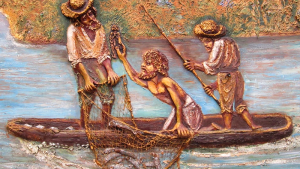In 2013, Pope Francis visited the enormous basilica dedicated to Our Lady of Aparecida. Who is she, and why does she matter?
Patroness of Brazil
The tiny clay image of the Blessed Virgin represents Mary under her particular title as Patroness of Brazil. Travelers to the country testify to her presence as a sign of Brazilian Catholicism. She is seen on bumper stickers and posters, her image is made into jewelry, and replicas of the Virgin of Aparecida adorn most Catholic homes, businesses, and schools.
Jenny Barchfield of the Associated Press quotes Father Jose Arnaldo Juliano dos Santos: “Her face is the face of the Brazilian people. She’s the great unifier of Brazil, who reaches across all sorts of divisions of race, class, region, and religion, and brings us all together as a people.”
Just 15 inches tall, the image of the Virgin of Aparecida stands over a crescent moon with her hands lifted to her breast in prayer. She gazes upward with a beatific smile on her face.
A “Black Madonna” found by fishermen
The statue appeared in 1717 in a small Brazilian town. Some fishermen hauled up the image in their net and, after a night of empty netted fishing, pulled in a great catch. After the image remained in the fisherman’s family for 15 years, a series of miracles began to be attributed to her. Pilgrims flocked to the little image, and a series of churches were built in her honor, culminating in the huge basilica that now houses the statue.
Secular commentators on the Pope’s visit to the Shrine of Our Lady of Aparecida are inclined to connect the dark color of the statue with the multi-racial and African-rooted population of Brazil. Barchfield quotes a theology professor from Brazil, Fernando Altemeyer: “We are a nation of African descendants, so this black Virgin in a country of blacks has a huge place of honor. For black Catholics, Our Lady of Aparecida is obviously the same color as they are. It’s the feeling of ‘She’s black, like us!’ so it’s incredibly important for them.”
Perhaps, but the fact is the original image would have been painted in bright, realistic colors, and the statue’s present dark complexion has more to do with the fact that she was underwater for decades and the accumulation of soot from candles than any intention that she be a “Black Madonna.” And while there is nothing wrong with Afro-Brazilians identifying with the Virgin of Aparecida in this way, her true significance is greater.
Connection to Our Lady of Guadalupe
The posture of the Virgin of Aparecida is typical of images of Mary portraying the Immaculate Conception. That she was discovered in 1717 (137 years before the formal definition of the Dogma of the Immaculate Conception) reveals that the devotion and belief in the dogma was already widespread. Furthermore, her dark complexion, her posture of prayer, and her position on the crescent moon is the same as the miraculous image of Our Lady of Guadalupe. Even more interesting, the United States is also under the patronage of the Immaculate Conception, to which the great shrine in Washington, DC stands as witness.
The main importance of the Virgin of Aparecida is therefore not the charming legend of her discovery by fishermen or the stories of miracles, but the fact that her image is that of the Immaculate Conception. This connects her to that great Marian image in Mexico as well as to the Patroness of the United States. It is no coincidence that this dogma of the Church surged into prominence and importance in the 16th and 17th centuries, culminating in the definition of the dogma in 1854. This was the age of revolution and reform that saw the rise of rationalism and secular humanism.
Why is the Immaculate Conception important?
The dogma of the Immaculate Conception of the Blessed Virgin Mary is the belief that God interrupted the flow of human history by a special act and preserved Mary from the stain of original sin from the first moment of her conception. This action of God reminds us of two important truths – truths which have been obliterated in the rationalist, secular-humanist modern world.
The first is that God is alive and at work in the world. He has not abandoned the human race, but he cares enough to be involved. Through a special act he preserved the Virgin Mary from the stain of original sin, and through this unique action he reminds us that he is still engaged with the human race in our eternal struggle. This world is not empty of God and empty of grace, but it is still charged with the grandeur and humility of God. Rationalism is not the final answer. The miraculous is still alive in the world.
Secondly, the Immaculate Conception reminds us that human life is sacred from the first moment of conception. We are taught by divine revelation and by divine interaction with the world that the first moment of human life is the moment of conception. In a world threatened by genocide, suicide, war, murder, abortion, and euthanasia, the Blessed Virgin – under her titles of Aparecida and Guadalupe – speak to the world of the sacredness of human life and of God’s care and love for the human race.
Our Lady and the Americas
Finally, it is no mistake that the Immaculate Conception is the primary image of the Americas. The Americas are the ultimate battleground in the war between secular, godless humanism and the divine mercy of God in the world. The blessed Virgin, Immaculately and miraculously conceived, offers her son for the Redemption of the world and the conversion of the Americas.
The Pope’s visit to the Basilica Shrine of Our Lady of Aparecida echoes this call and reminds us all that God’s secret plan for the world is far greater than we can ever imagine, and that Jesus Christ – born of the Virgin Mary – is not finished with us yet.
Fr. Dwight Longenecker is the parish priest of Our Lady of the Rosary Church in Greenville, South Carolina. Visit his blog, browse his books, and be in touch at dwightlongenecker.com.



